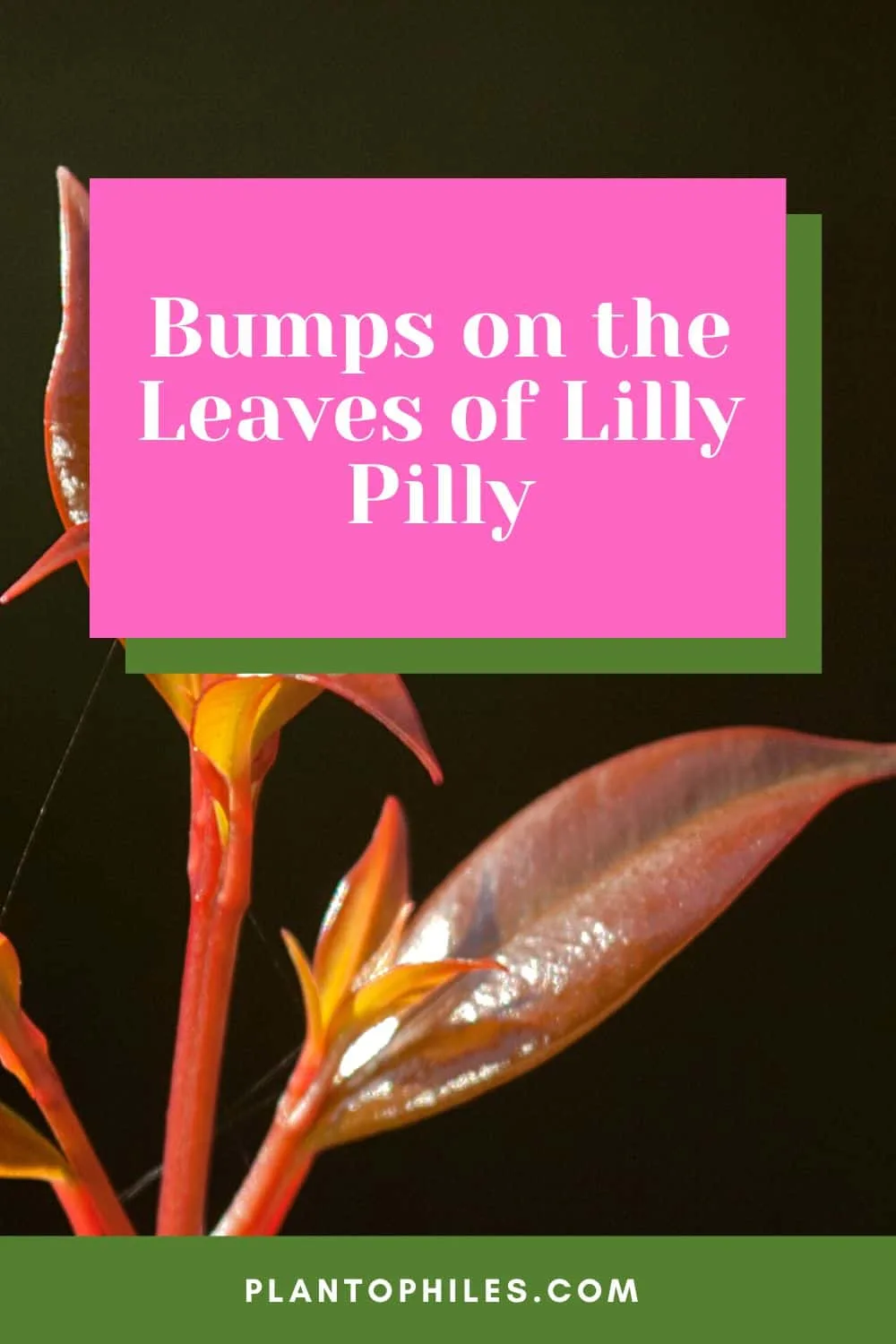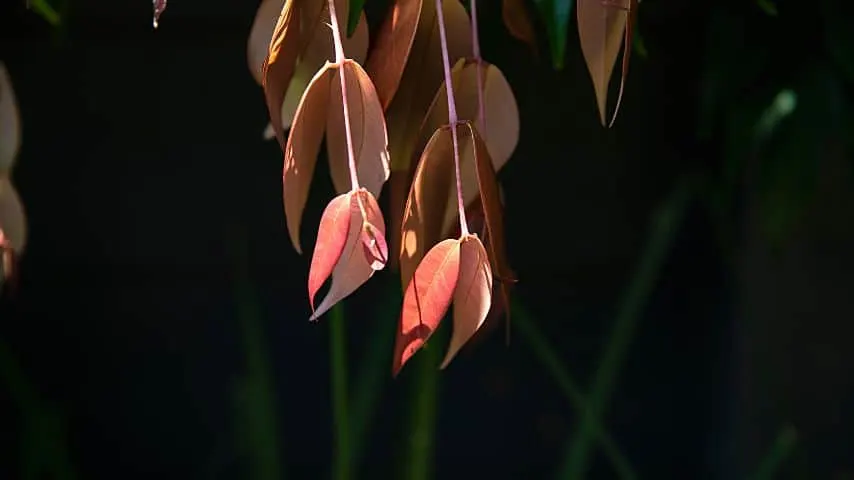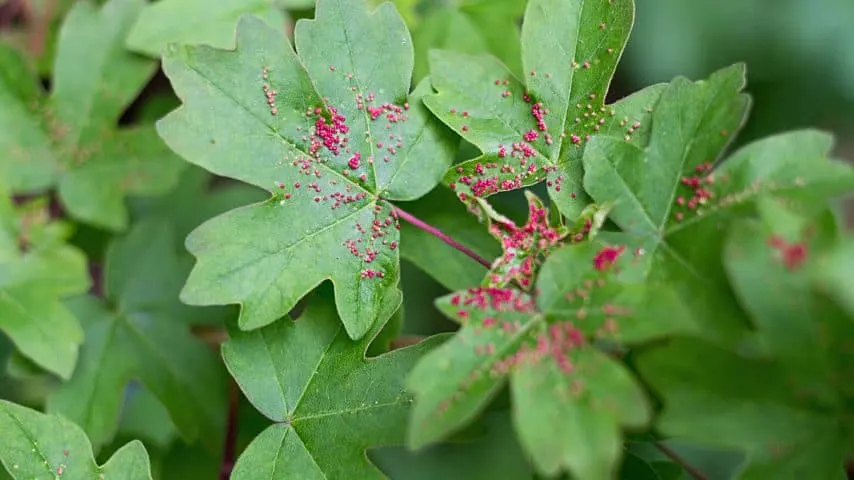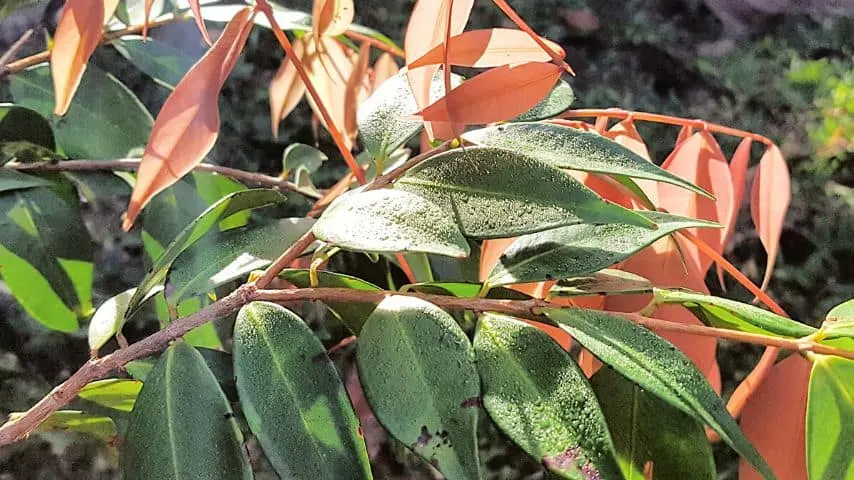Bumps on the leaves of lilly pilly. Lilly pilly (Syzygium smithii) trees and bushes belong to the Myrtaceae family. They produce tart, oval, and magenta berries that can be used in various foods, including jams, cakes, and chutneys.
These Myrtle trees are native to Australia and Southern Asia. Depending on the cultivar, they range in size from three to thirty-two feet.
When they are healthy, they have sleek, thin leaves that range from bright green to pink.
It can therefore be quite alarming when raised red bumps on the leaves of Lilly pilly trees appear.
This article provides a guide to identifying the bumps on your Lilly pilly leaves, explains why the problem is occurring and recommends plans for treatment and prevention.
Table of Contents
What are the Bumps on my Lilly Pilly Leaves?
Bumps on lilly pilly leaves are caused by psyllids or scale. Psyllids cause red, raised bumps on the leaf tops which can be treated by pruning affected leaves. Prevent psyllid infestations using insecticides before the growing season begins. White wax scale creates white lumps under the leaves, which you can treat with eco-horticultural oil.

How to Identify Bumps on Lilly Pilly Leaves
The most important thing to do when bumps appear on Lilly pilly leaves is to correctly identify the problem and then take steps to treat it immediately.
Psyllid damage appears predominantly on Syzgium varieties of Lilly pilly, so watch for signs of an infestation if you are caring for a Syzgium.

Psyllid damage causes Lilly Pilly leaves to look deformed and warps their usually sleek surface into contorted, red, bumpy shapes.
In the majority of cases, bumps on Lilly pilly leaves are caused by psyllids, but there are rare times when bumps might be caused by white wax scale.
Bumps on Lilly Pilly leaves caused by scale look very different from psyllid damage.
Psyllid lumps resemble acne and are red or pink –– they look similar to the bumps on the leaves of maple trees caused by mites.

Psyllid damage emerges on the top of Lilly Pilly leaves, making them look like their surfaces have been pressed outward.
Scale bumps look like little, white, waxy balls stuck to the underside of leaves.
What Causes Bumps on Lilly Pilly Leaves
Insects cause bumps on Lilly Pilly leaves called psyllids, which create acne-like lumps by sucking the sap out of newly unfurling leaves.
Psyllids eat the new growth from the underside of the young leaves.
The damage to the leaves combined with the chemical composition of psyllids’ mouths causes the leaves to harden into lumps to prevent the effect of the wounds from spreading.
This leads to the appearance of those tell-tale, pimple-like bumps.
White wax scale creates bumps on Lilly Pilly leaves when mature female scales lay pale pink eggs.
These eggs harden onto the leaves, and a waxy encasing grows around them to protect them from potential predators.
How to Treat Bumps on Lilly Pilly Leaves
Unfortunately, just as is true of bumps on the leaves of pecan trees, once psyllid damage has been done to Lilly Pilly leaves, they are beyond saving.
Fortunately, psyllid bumps are primarily a cosmetic issue, and they should not pose a long-term health risk to your plant unless the insects are left to spread unchecked.
Cut off any damaged leaves and collect the affected foliage. Place the pruned leaves inside an air-tight plastic bag, making sure to dispose of it properly.

If push comes to shove and you are fed up with trying to remove psyllids and psyllid damage from your Lilly Pillies, you can also purchase and plant psyllid-resistant varieties.
If the bumps on your Lilly Pilly leaves are white wax scale, you can treat them in the same way you would treat brown scale on plants.
Get rid of the egg encasings on your plant’s leaves by applying eco-friendly horticultural oil.
This can be done anytime, and you do not necessarily need to remove damaged leaves from your Lilly Pilly plant. You can simply apply your eco oil to your plant using rubber gloves.
Carefully massage the undersides of your leaves where the bumps appear, and apply as much pressure as necessary to remove the lumps cleanly.
Dispose of the scale eggs and encasings by placing them in an air-tight plastic bag and disposing of them in regular waste disposal.
Rinse your plant by wiping it down with a wet washcloth.
If you notice a black, sooty mold in and around the waxy scale of a lumpy Lilly Pilly, an eco-horticultural oil may not be enough.
Treat the infestation by choosing an insecticide and applying it liberally to your plant.
Wipe down your stem and the undersides of your leaves with a damp washcloth to ensure that you have removed not only the scale but also the sooty mold, which can interfere with Lilly Pillies’ ability to photosynthesize if left untreated.
How to Prevent Bumps on Lilly Pilly Leaves
To prevent bumps on Lilly Pillies, it is essential to keep your plant healthy. The weaker and more stressed a Lilly Pilly bush is, the less well it will be able to fight off a psyllid infestation.
Give your Lilly Pillies appropriate care to keep them in good condition.
If a Lilly Pilly already has to manage stresses, such as insufficient plant food or too little water or sunlight, it will struggle to cope with the damage caused by psyllids or scale.
Lilly Pillies need to be kept in consistently moist soil during the growing season (summer in the northern hemisphere and winter in the southern hemisphere).
Use organic fertilizer to feed your Lilly Pilly at least once yearly, preferably at the end of the growing season, in preparation for next year.
Lilly pilly leaf disease
The most common lilly pilly leaf diseases are:
- Myrtle rust (Anthracnose)
- Leaf Spot disease (Mycosphaerella Leaf Spot)
- Tiny black dots on lilly pilly leaves (Cercospora Leaf Spot)
- A soil-borne water mold (Phytophthora Dieback)
- Funga foliage disease (Powdery Mildew)
Conclusion On Bumps on the Leaves of Lilly Pilly
The main reasons for bumps on lilly pilly leaves are caused by psyllids or scale insects. Prune the affected leaves and treat the healthy leaves using horticultural oil

Daniel has been a plant enthusiast for over 20 years. He owns hundreds of houseplants and prepares for the chili growing seasons yearly with great anticipation. His favorite plants are plant species in the Araceae family, such as Monstera, Philodendron, and Anthurium. He also loves gardening and is growing hot peppers, tomatoes, and many more vegetables.


